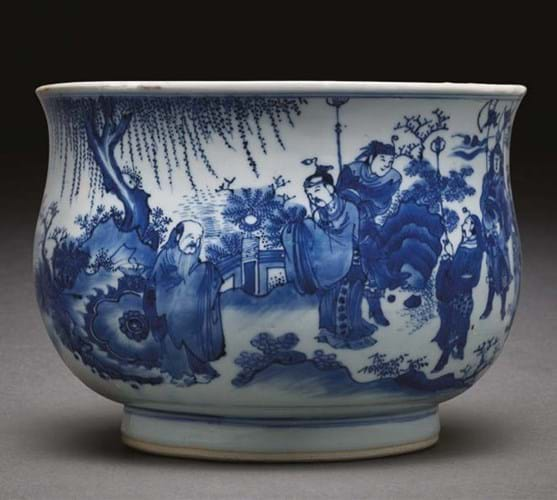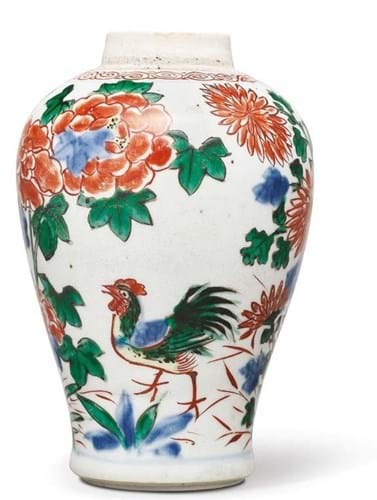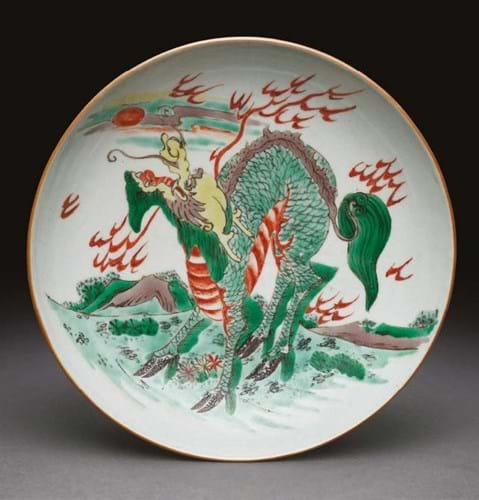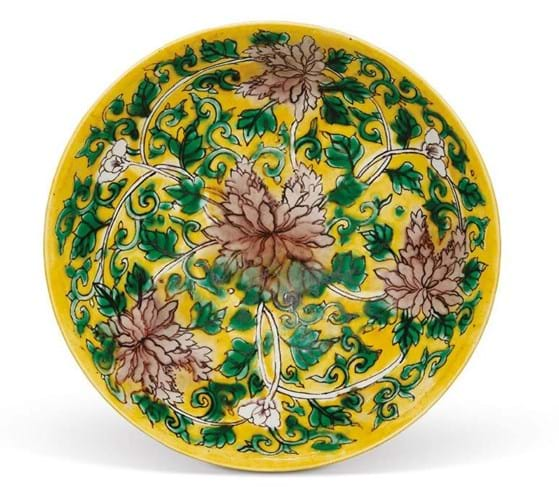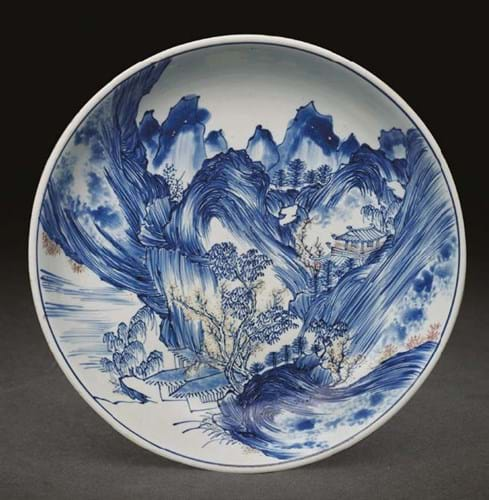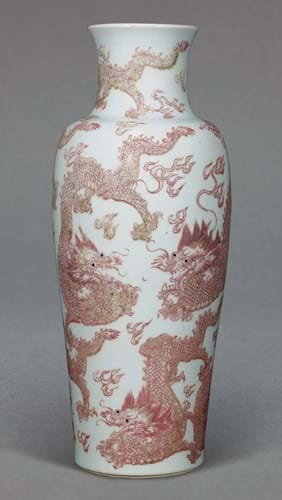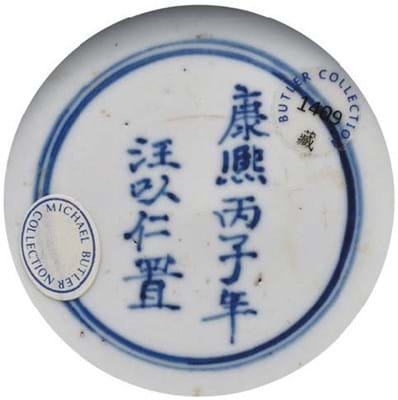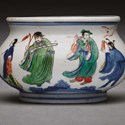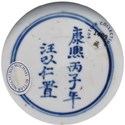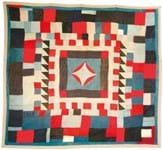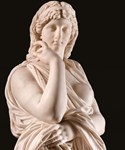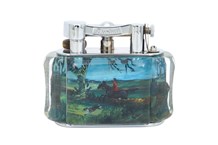Parallel to a distinguished career in the Foreign Office – as Britain’s man in Brussels he secured Margaret Thatcher’s famous 1984 European Community’s budget rebate – was a deep appreciation of Chinese porcelain.
Butler had purchased his first piece, a green glazed, bamboo-shaped winepot at Sotheby’s in 1961. He paid £14 for it as part of a box lot, beginning a collecting odyssey that in time would gravitate towards an area that – if not quite neglected – was certainly less studied and more affordable than ‘prime period’ wares of the 16th and the 18th centuries.
As documented in the carefully annotated ledgers and purchase records, that he kept after 1965, his primary passion became the socalled Transitional porcelains made in the late Ming and early Qing eras (1620-83) when court patronage of the porcelain capital of Jingdezhen all but dried up.
Instead, ceramics were made for merchants, scholars and for export with production – styles, shapes, glazes and subject matter – far more diverse than during ‘imperial’ times.
Ultimately, as he recalls in a video accessible on YouTube, Butler did manage to convince fellow members of the Oriental Ceramic Society that ‘some of these late pieces are rather good’. By the end of his life, he had amassed over 800 items and built a seven-room museum in the grounds of the Dorset family home to house many of them.
Tainted inheritance
However, the inheritance of the finest collection of 17th century Chinese porcelain in the UK brought less joy to his four children. The Daily Telegraph described it as “a multimillion- pound bomb at the heart of a family – detonating immediately after the patriarch’s death”.
Two children (Charles and Katharine Butler) were determined to honour their father’s wishes and keep his legacy intact. Two elder siblings (James and Caroline Butler) wished to receive their 25% share. The 2016 High Court case of ‘Butler and Butler versus Butler and Butler’ aired the family’s laundry, cost £1m in legal fees and ultimately led to the decision that the 502 pieces in the museum collection could be broken up.
Licking their wounds, Charles and Katharine closed the museum. However, they were determined to refill the empty shelves.
Since 2016 they have been plugging holes in the collection with pieces from Butler’s two homes and some 75 purchases at auction or retail. They were also the most active buyers when 60 pieces from the family collection were sold for £2.3m at Christie’s Hong Kong (26/20/14.5% buyer's premium) on November 29. The vendor was their elder brother James.
In total, Charles and Katharine Butler bought 16 pieces at the sale including the opening lot – a Tianqi (1621-27) blue and white bowl their father had been excited to acquire from a London dealer who had found it in a German schloss. At 17½in (44cm) across, it must rank among the largest pieces made in the period and is brilliantly decorated with scenes of figures on rafts, figures traveling on horseback and figures playing chess against a background of a pagoda. A fortress may be the Great Wall itself.
Like many pieces on offer, this bowl is published in at least two books – the catalogue from the 2006 Beauty’s Enchantment exhibition of 17th century porcelain at the Shanghai Museum and a new bilingual catalogue Leaping the Dragon Gate – The Sir Michael Butler Collection of 17th Century Chinese Porcelain published last year by Katharine Butler and the scholar Teresa Canepa.
Estimated at up to HK$250,000, it took HK$420,000 (£40,000).
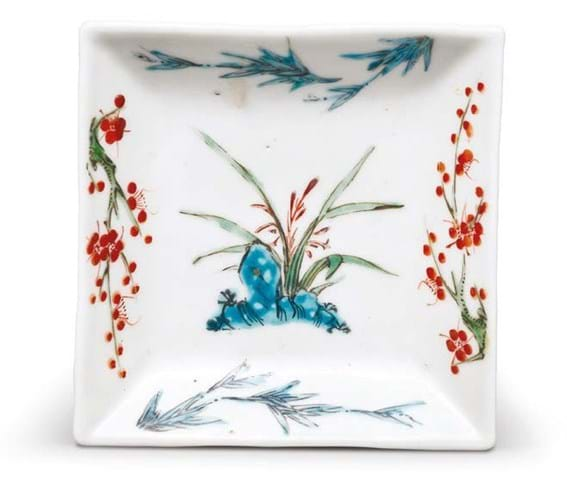
Tianqi (1621-27) dish decorated with a flower emerging from a rock, 3¾in (9cm) – HK$35,000 (£3350) at Christie’s Hong Kong.
Story telling
Narrative decoration depicting episodes from China’s rich tradition of the literary epic is a leitmotif of many Transitional wares.
The scene on a 9in (23cm) incense burner made in the reign of Chongzhen (1628-44), the 17th and last Ming emperor, is taken from the popular novel Fengshen Yanyi (The Investiture of the Gods) first published in the 1550s.
An appropriate subject for a tumultuous era, it depicts the meeting between the future Zhou emperor Wen and Jiang Ziya, a military strategist who had gone into countryside exile to await the arrival of a just ruler. The decoration – a type Michael Butler dubbed ‘High Transitional’ – gives the lie to any notion that imperial control was a prerequiste of great porcelain.
It doubled estimate at HK$1.1m (£104,750).
Sir Michael worked closely with scholars to create a more informed and structured approach to 17th century porcelains. It is a primary reason the collection is so well known at home and abroad.
The exhibition Chinese Porcelain: The Transitional Period 1620-1683: A Selection from the Michael Butler Collection was held at the Princessehof in the Netherlands in 1986, while Seventeenth Century Chinese Porcelain from the Butler Family Collection travelled to 12 US museums in 1990.
Particularly influential was the exhibition and catalogue that turned an academic focus on porcelain from the reign of Shunzhi (1644-61), the first Qing ruler over China proper. Treasures from an Unknown Reign: Shunzhi Porcelain, 1644-1661 toured in Honolulu, Dallas and Charlottesville in 2002.
Among the highlights was an elegant 16½in (42cm) blue and white sleeve vase decorated with birds at play amid blossoming flower branches and bamboo. A particularly fine example of the type, it was one of Butler’s favourite pieces.
It will return to the collection after it was bought at HK$1.2m (£114,300), double the estimate.
Many Shunzhi underglaze blue and coloured enamel pieces sold a distance above published guides.
Pitched at HK$20,000-30,000 each, an 8in (21cm) ‘qilin’ dish decorated with the mythical beast surrounded by flames sold at HK$160,000 (£15,250), while a 7in (17cm) aubergine and green enamelled yellow-ground ‘peony’ dish took HK$85,000 (£8100).
The relatively modest price ceilings that once existed for these wares has been broken in recent years. Sums of £50,000-plus are no longer uncommon for the best pieces.
Christie’s sale included four pieces in the ‘Master of the Rocks’ style – the term coined by the English collector Gerald Reitlinger to describe dramatic ‘pencil and wash’ rocky landscape decoration.
The style, known in Chinese as pima cun shanshui, was once thought to be the work of one master Kangxi decorator, but is now understood to have been executed by several hands.
A large 13in (33cm) blue and copper red deep-sided dish finely decorated with pavilions set within a mountainous landscape – the leaves and furniture highlighted in copper red – was the most eagerly contested piece in the auction selling at a mighty HK$1.9m (£181,000) against a top estimate of HK$200,000.
It was one of half-a-dozen major lots to sell to the same paddle from mainland China.
Another was perhaps the finest of the Kangxi vases in this offering, a 17in (43cm) high tapered baluster vase finely rendered in copper-red with the nine four-clawed dragons that guard the Gate of Heaven. Close inspection shows the eyes of these writhing celestial beasts are picked out in underglaze blue.
Although the base is inscribed with an apocryphal six-character Chenghua mark, by this moment imperial control had been reasserted over the kilns.
Butler had bought it in 1968 for £325 – his biggest outlay to date at the time. Today it is thought to be unique, with its closest comparison a two-dragon vase in the Percival David collection. Underbid by Katharine Butler, it sold for four times the top estimate at HK$4.8m (£457,150).
The dating question
Inscribed and dated pieces often command a premium. However ‘inconvenient’ they occasionally prove to be when arranging pieces into groups or categories, these are the best benchmarks.
Sir Michael’s keen interests included the group of wares he called ‘the 1660s dishes’ and the blue and red decorated pieces with the enigmatic mark Zhonghe Tang (Hall of Central Harmony) and dates from 1671-73.
The family research is continuing: two more Zhonghe Tang dishes have been acquired in recent years with plans afoot for an online database of dated 17th century porcelain, assisted by scientific analysis through mass spectrometry.
One dated piece here that Katharine Butler was keen to return to the collection was a 6in (15cm) wucai censer painted with figures of the Eight Daoist Immortals. The inscription Kangxi bingzi nian Wang Yiren zhi, translates as ‘Commissioned by Wang Yiren in the bingzi year of Kangxi’ – a cyclical date corresponding to 1696. It sold within hopes at HK$320,000 (£30,500).
One that got away was a 20in (50cm) baluster vase decorated with a landscape scene, 15 lines of the poem Zuiweng tingji (Essay on the Pavilion of the Drunken Old Man) plus the date 1721. Underlining the ‘Butler premium’ it sold for HK$550,000 (£52,400).
The large vessel was known in the family as the ‘tot pot’ as it had been big enough to hold the children as babies. However, future visitors to the museum will be able to see a very similar piece, one dated 1720 that was bought in Paris in 2017 for a more modest €16,000.
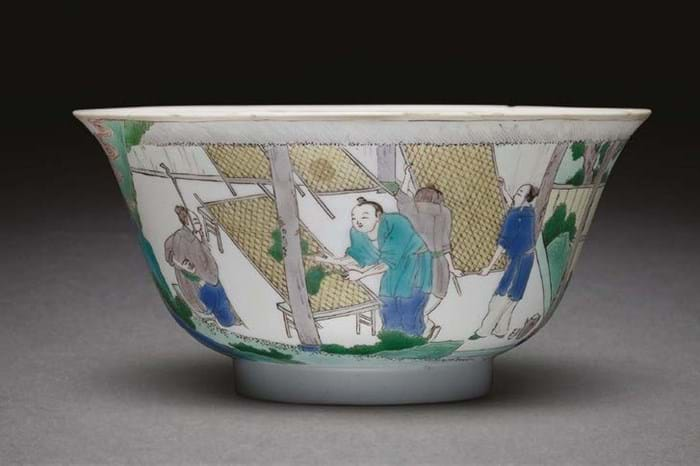
Kangxi famille verte ‘weavers’ bowl with inscription – HK$320,000 (£30,500) at Christie’s Hong Kong.
Back on display
With the return of the 16 pieces from the original collection, more than 650 pieces of 17th century Chinese porcelain are now on display at the refurbished Butler Collection. Katharine Butler gave her first guided tour of the collection last week and will continue monthly ‘by appointment’ viewings at the Dorset museum to groups of up to 20.
Crucially for those wishing to really learn about the subject, the pieces are there to be handled. None are kept behind glass.


